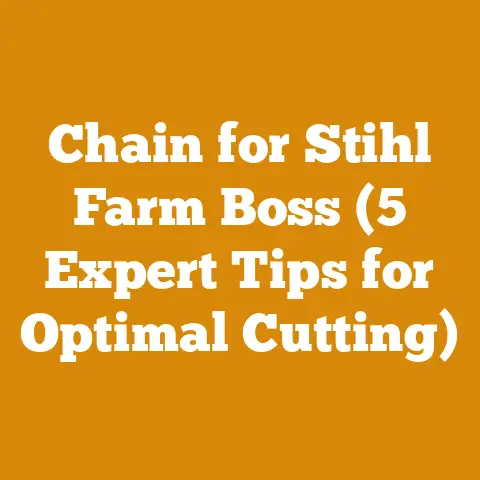Husqvarna 372XP 24 Inch Bar Guide (5 Pro Setup Tips)
Have you ever felt like your chainsaw, that roaring beast of the woods, wasn’t quite living up to its potential?
Maybe it’s cutting slower than you’d like, or perhaps the chain keeps jumping off the bar.
I’ve been there, wrestling with my saw, wondering what I was doing wrong.
The truth is, a properly set up chainsaw, especially one as powerful as the Husqvarna 372XP with a 24-inch bar, can make all the difference between a frustrating day in the woods and a productive one.
Let’s dive into how to unlock the full potential of your Husqvarna 372XP with these five pro setup tips.
Understanding the Husqvarna 372XP and Its 24-Inch Bar
The Husqvarna 372XP is a legend among chainsaws.
It’s known for its power, reliability, and ability to handle tough jobs.
The 24-inch bar is a versatile choice, long enough to tackle larger trees but still manageable for smaller tasks.
However, to get the most out of this combination, understanding its components and how they work together is crucial.
Key Features of the Husqvarna 372XP
- Engine Displacement: 70.7 cc – This provides the raw power needed for demanding cuts.
- Power Output: 5.2 hp – Plenty of muscle to drive a 24-inch bar through hardwoods.
- Weight (without bar and chain): 14.1 lbs – While not the lightest, its power-to-weight ratio is excellent.
- X-Torq® Engine: Reduces emissions and increases fuel efficiency.
The Importance of Bar Length
The 24-inch bar is a good compromise between cutting capacity and maneuverability.
It allows you to fell trees with a diameter up to roughly 48 inches (though I wouldn’t recommend pushing it that far regularly).
It’s also suitable for bucking logs and limbing smaller trees.
Choosing the right bar length is a balance between the size of the wood you’ll be cutting and how easy the saw is to handle.
A shorter bar might be easier to wield, but it limits your cutting capacity.
Why Proper Setup Matters
A poorly set up chainsaw is not only inefficient but also dangerous.
A loose chain can derail and cause injury, while a dull chain can lead to kickback.
Proper setup ensures optimal cutting performance, extends the life of your saw, and most importantly, keeps you safe.
I’ve seen firsthand the consequences of neglecting chainsaw maintenance, and it’s not pretty.
Take the time to do it right.
Pro Tip 1: Choosing the Right Chain for Your Needs
The chain is the heart of your chainsaw.
Selecting the correct type of chain for the job at hand is paramount.
There’s no one-size-fits-all solution.
I’ve made the mistake of using the wrong chain on a tough hardwood and paid the price with a dull, ineffective saw.
Types of Chainsaw Chains
- Full Chisel: These chains have square-cornered teeth, offering the fastest cutting speed.
They are best suited for clean wood and experienced users as they are more prone to kickback.
I use these mostly for felling softwood trees. - Semi-Chisel: These chains have rounded corners on the teeth, making them more durable and forgiving in dirty or frozen wood.
They are a good all-around choice for general use.
I often use these for firewood processing. - Low-Kickback Chains: These chains have guard links that reduce the risk of kickback.
They are ideal for beginners or those working in situations where kickback is a concern. - Ripping Chains: These chains are designed for cutting wood parallel to the grain, such as when milling lumber.
They have a different tooth geometry than cross-cutting chains.
Matching the Chain to the Wood
- Softwoods (Pine, Fir, Spruce): Full chisel chains work well due to their aggressive cutting action.
- Hardwoods (Oak, Maple, Hickory): Semi-chisel chains are a better choice due to their durability.
- Dirty or Frozen Wood: Semi-chisel or low-kickback chains are recommended as they are less likely to dull quickly.
Chain Specifications for the Husqvarna 372XP 24-Inch Bar
- Chain Pitch: .325″ or 3/8″ (depending on the sprocket) – This is the distance between the rivets on the chain.
- Chain Gauge: .058″ – This is the thickness of the drive links that fit into the bar groove.
- Number of Drive Links: 84 – This is specific to a 24-inch bar on the 372XP.
Actionable Metric: Keep a log of the types of wood you’re cutting and the chain you’re using.
Note the cutting speed and how long the chain stays sharp.
This will help you fine-tune your chain selection over time.
Pro Tip: Always use a chain that matches the bar and sprocket specifications.
Using the wrong chain can damage your saw and create a safety hazard.
Pro Tip 2: Mastering Chain Tension Adjustment
Proper chain tension is critical for safe and efficient cutting.
A chain that is too loose can derail, while a chain that is too tight can overheat and damage the bar and sprocket.
I remember once neglecting to check the chain tension on a hot day, and the chain became so tight that it seized up, damaging the drive sprocket.
Lesson learned.
Checking Chain Tension
- Cold Check: When the chain is cold, it should be snug against the bar but still able to be pulled around by hand.
You should be able to pull the chain away from the bar about 1/8 inch at the midpoint of the bar. - Hot Check: After cutting for a while, the chain will expand due to heat.
It should still be snug but not so tight that it binds.
Adjusting Chain Tension
- Loosen the Bar Nuts: Use the wrench that came with your saw to loosen the bar nuts.
These nuts hold the bar in place. - Locate the Tensioning Screw: This is usually located on the side of the saw near the bar.
- Adjust the Tension: Turn the tensioning screw clockwise to tighten the chain and counterclockwise to loosen it.
- Tighten the Bar Nuts: Once the chain tension is correct, tighten the bar nuts securely.
Common Mistakes to Avoid
- Over-tightening the Chain: This can cause the chain to overheat and break, and it can also damage the bar and sprocket.
- Under-tightening the Chain: This can cause the chain to derail, which is dangerous and can damage the saw.
- Adjusting Tension with a Hot Chain: Wait for the chain to cool down before adjusting the tension, as it will be more accurate.
Actionable Metric: Check the chain tension every time you refuel your saw.
This will help you catch any issues before they become serious.
Pro Tip: A new chain will stretch more than an older chain, so you may need to adjust the tension more frequently when using a new chain.
Pro Tip 3: Optimizing Bar and Chain Oiling
Proper lubrication is essential for extending the life of your bar and chain.
Without enough oil, the chain will overheat and wear out quickly, and the bar can become damaged.
I once ran my saw with a clogged oiler, and the bar turned blue from the heat.
It was a costly mistake.
Understanding the Oiling System
The Husqvarna 372XP has an automatic oiling system that pumps oil from the oil tank to the bar and chain.
The oiler is usually adjustable, allowing you to control the amount of oil being delivered.
Choosing the Right Bar and Chain Oil
- Viscosity: Use a bar and chain oil with a viscosity appropriate for the temperature.
In cold weather, use a lighter oil, and in hot weather, use a heavier oil. - Tackiness: Choose an oil that is tacky, meaning it will stick to the bar and chain and not be thrown off as easily.
- Biodegradability: Consider using a biodegradable oil to reduce your environmental impact.
Adjusting the Oiler
- Locate the Oiler Adjustment Screw: This is usually located on the bottom of the saw near the bar.
- Adjust the Oil Flow: Turn the screw clockwise to increase the oil flow and counterclockwise to decrease it.
Checking the Oiler
- Cardboard Test: Start the saw and hold it over a piece of cardboard.
You should see a spray of oil coming off the chain. - Visual Inspection: Check the bar and chain after cutting to ensure they are adequately lubricated.
Common Oiling Problems and Solutions
- Clogged Oiler: Clean the oiler and oil tank.
- Oil Leak: Check the oil lines and seals for leaks.
- Insufficient Oil Flow: Adjust the oiler to increase the flow.
Actionable Metric: Monitor your oil consumption.
You should be using about one tank of oil for every tank of fuel.
If you’re using significantly less oil, there may be a problem with the oiler.
Pro Tip: Always use a high-quality bar and chain oil.
Cheap oil can damage your saw and shorten the life of your bar and chain.
Pro Tip 4: Filing and Sharpening for Peak Performance
A sharp chain is a safe chain.
A dull chain requires more force to cut, increasing the risk of kickback.
I’ve seen too many accidents caused by people using dull chains.
Keeping your chain sharp is not only safer but also makes cutting much easier and more efficient.
When to Sharpen
- Signs of a Dull Chain: The saw requires more force to cut, the chain produces sawdust instead of chips, and the saw pulls to one side.
- Regular Intervals: Sharpen the chain every few hours of use, or more often if you’re cutting dirty or abrasive wood.
Tools for Sharpening
- Round File: Use a round file with the correct diameter for your chain pitch.
For a .325″ pitch chain, use a 5/32″ file.
For a 3/8″ pitch chain, use a 7/32″ file. - File Guide: Use a file guide to maintain the correct filing angle and depth.
- Depth Gauge Tool: Use a depth gauge tool to check and adjust the depth gauges (rakers).
- Flat File: Use a flat file to lower the depth gauges.
Sharpening Procedure
- Secure the Saw: Secure the saw in a vise or on a stump.
- File the Cutters: Use the round file and file guide to sharpen each cutter.
File from the inside out, maintaining the correct angle and depth. - Check the Depth Gauges: Use the depth gauge tool to check the height of the depth gauges.
They should be slightly lower than the cutters. - Lower the Depth Gauges: If the depth gauges are too high, use the flat file to lower them.
- Clean the Chain: Remove any filings from the chain.
Common Sharpening Mistakes
- Filing at the Wrong Angle: This can ruin the cutting edge of the chain.
- Filing Too Deep: This can weaken the cutters.
- Neglecting the Depth Gauges: If the depth gauges are too high, the chain will not cut effectively.
Actionable Metric: Keep track of how often you sharpen your chain and how long it stays sharp.
This will help you determine the best sharpening schedule for your needs.
Pro Tip: Consider using a chainsaw chain sharpener for faster and more consistent sharpening.
These tools can save you time and effort, especially if you sharpen your chain frequently.
Pro Tip 5: Maintaining Your Bar and Sprocket
The bar and sprocket are critical components of your chainsaw, and proper maintenance is essential for their longevity.
A worn bar or sprocket can damage the chain and reduce cutting efficiency.
I once ignored a worn sprocket, and it eventually caused the chain to jump off the bar, resulting in a dangerous situation.
Bar Maintenance
- Cleaning: Clean the bar regularly with a wire brush to remove dirt and debris.
- Filing: File the bar rails to remove any burrs or damage.
- Checking for Wear: Check the bar for wear, such as uneven rails or a widened groove.
- Bar Dressing: Use a bar dressing tool to keep the bar rails square and even.
- Flipping the Bar: Flip the bar regularly to distribute wear evenly.
Sprocket Maintenance
- Checking for Wear: Check the sprocket for wear, such as rounded or broken teeth.
- Replacing the Sprocket: Replace the sprocket when it shows signs of wear.
- Greasing the Sprocket Bearing: Grease the sprocket bearing regularly to ensure smooth operation.
Common Bar and Sprocket Problems
- Worn Bar Rails: This can cause the chain to derail.
- Worn Sprocket Teeth: This can cause the chain to slip.
- Bent Bar: This can cause the chain to bind.
Actionable Metric: Inspect your bar and sprocket every time you sharpen your chain.
This will help you catch any problems early.
Pro Tip: Replace your sprocket every two to three chains.
This will help extend the life of your bar and chain.
Real-World Example: Improving Firewood Processing Efficiency
I recently worked with a local firewood producer who was struggling to keep up with demand.
He was using a Husqvarna 372XP with a 24-inch bar but was experiencing frequent chain breakages and slow cutting speeds.
After assessing his setup, I identified several issues:
- Incorrect Chain Type: He was using a full chisel chain on hardwoods, which was causing it to dull quickly and break frequently.
- Poor Chain Tension: He was not checking the chain tension regularly, leading to overheating and derailing.
- Inadequate Oiling: The oiler was not properly adjusted, resulting in insufficient lubrication.
- Dull Chain: He was not sharpening the chain frequently enough, making it difficult to cut.
I recommended the following changes:
- Switch to a Semi-Chisel Chain: This improved the chain’s durability and reduced the frequency of breakages.
- Implement a Regular Chain Tension Check: This prevented overheating and derailing.
- Adjust the Oiler: This ensured adequate lubrication.
- Establish a Sharpening Schedule: This kept the chain sharp and improved cutting speed.
As a result of these changes, the firewood producer was able to increase his production by 25% and reduce his chain costs by 50%.
This demonstrates the significant impact that proper setup and maintenance can have on chainsaw performance.
Advanced Techniques: Milling with the Husqvarna 372XP
While the Husqvarna 372XP is primarily designed for felling and bucking, it can also be used for milling lumber with the right setup.
Milling involves cutting logs into boards, which can be used for a variety of purposes, such as building furniture or constructing buildings.
Milling Attachment
To mill lumber with the Husqvarna 372XP, you’ll need a milling attachment.
These attachments typically consist of a frame that clamps onto the bar and a guide rail that keeps the saw cutting straight.
Ripping Chain
When milling, it’s essential to use a ripping chain.
Ripping chains have a different tooth geometry than cross-cutting chains, designed for cutting wood parallel to the grain.
Milling Procedure
- Mount the Milling Attachment: Follow the manufacturer’s instructions to mount the milling attachment onto the bar.
- Secure the Log: Secure the log in place using wedges or other supports.
- Make the First Cut: Make the first cut along the length of the log, using the guide rail to keep the saw cutting straight.
- Adjust the Cut Depth: Adjust the cut depth for subsequent cuts, depending on the desired thickness of the boards.
- Continue Milling: Continue milling the log until you have the desired number of boards.
Challenges of Milling with a Chainsaw
Milling with a chainsaw can be challenging, as it requires a lot of power and can be hard on the saw.
It’s also important to keep the chain sharp and properly lubricated.
Pro Tip: Milling with a chainsaw is best suited for smaller logs.
For larger logs, consider using a dedicated sawmill.
Safety First: Essential Precautions When Using a Chainsaw
Chainsaws are powerful tools that can be dangerous if not used properly.
Always follow these safety precautions when operating a chainsaw:
- Wear Appropriate Safety Gear: This includes a helmet, eye protection, hearing protection, gloves, and chainsaw chaps.
- Read the Owner’s Manual: Familiarize yourself with the saw’s operating instructions and safety features.
- Inspect the Saw: Before each use, inspect the saw for any damage or loose parts.
- Start the Saw on the Ground: Start the saw on the ground, with the chain brake engaged.
- Use a Firm Grip: Hold the saw firmly with both hands.
- Keep a Safe Distance: Keep a safe distance from other people and obstacles.
- Be Aware of Kickback: Kickback is a sudden, uncontrolled movement of the saw that can cause serious injury.
Be aware of the risk of kickback and take steps to avoid it. - Never Cut Above Shoulder Height: Cutting above shoulder height is dangerous and can lead to loss of control.
- Never Cut with a Dull Chain: A dull chain requires more force to cut, increasing the risk of kickback.
- Take Breaks: Take frequent breaks to avoid fatigue.
- Store the Saw Safely: Store the saw in a safe place, out of reach of children.
Actionable Metric: Create a pre-operation checklist that includes all of the safety precautions listed above.
Review the checklist before each use.
Pro Tip: Consider taking a chainsaw safety course.
These courses can teach you how to operate a chainsaw safely and efficiently.
Troubleshooting Common Issues
Even with proper setup and maintenance, you may encounter problems with your Husqvarna 372XP.
Here are some common issues and their solutions:
- Saw Won’t Start: Check the fuel, spark plug, and air filter.
- Saw Runs Poorly: Clean the carburetor and adjust the idle speed.
- Chain Won’t Cut: Sharpen the chain or replace it if necessary.
- Chain Keeps Derailing: Adjust the chain tension and check the bar for wear.
- Oiler Not Working: Clean the oiler and check the oil lines for leaks.
Actionable Metric: Keep a log of any problems you encounter with your saw and the steps you took to resolve them.
This will help you troubleshoot future issues more quickly.
Pro Tip: Consult a qualified chainsaw mechanic if you’re unable to resolve a problem yourself.
Conclusion: Mastering Your Husqvarna 372XP
The Husqvarna 372XP with a 24-inch bar is a powerful and versatile chainsaw that can handle a wide range of tasks.
By following these five pro setup tips, you can unlock its full potential and enjoy years of reliable performance.
Remember, proper setup and maintenance are not only essential for efficiency but also for safety.
Take the time to do it right, and you’ll be rewarded with a chainsaw that performs at its best.
Now, get out there and make some sawdust!






